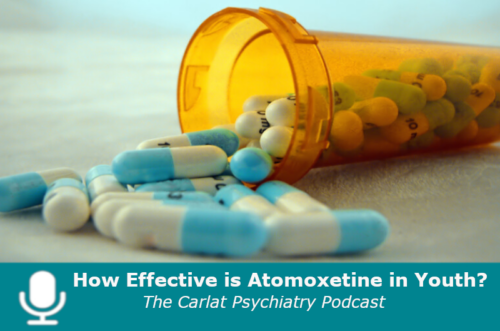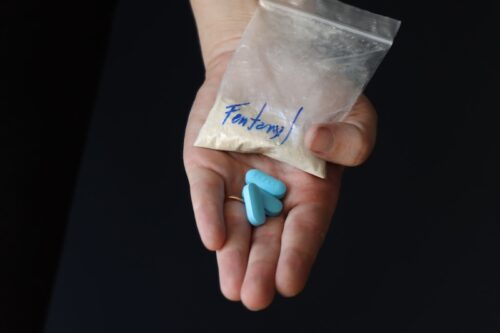With the recent approval of another non-stimulant ADHD medication (viloxazine, brand name Qelbree), this is a good time to revisit atomoxetine.
Published On: 06/27/2022
Duration: 13 minutes, 38 seconds
Referenced Article: “Atomoxetine for Children and Adolescents: An Update,” The Carlat Child Psychiatry Report, January/February/March 2022
Earn CME credits for this episode through the link in the podcast notes, and if you haven’t subscribed to the online issue give us a try, and take $30 off your first year’s subscription with the promo code PODCAST. Your support helps us operate free of industry influence.Transcript:
Dr. Feder: Since its FDA approval in 2002, Atomoxetine (brand name Strattera) has become a second or third line option (after stimulants and sometimes after central alpha agonists) for ADHD in both children and adults. With the recent approval of another non-stimulant ADHD medication (viloxazine, brand name Qelbree), this is a good time to revisit atomoxetine. How effective is it? What are some of its pros and cons? This podcast will clarify the position of atomoxetine in our toolbox for treating children and adolescents with ADHD.
Welcome to The Carlat Psychiatry Podcast.
This is another episode from the child psychiatry team.
I’m Dr. Josh Feder, The Editor-in-Chief of The Carlat Child Psychiatry Report and co-author of The Child Medication Fact Book for Psychiatric Practice and the brand-new book, Prescribing Psychotropics.
Mara: And I’m Mara Goverman, a Licensed Clinical Social Worker in Southern California with a private practice.
Dr. Feder: We have some exciting news for you! You can now receive CME credit for listening to this episode and all new episodes going forward on this feed. Follow the Podcast CME Subscription link in the show notes to get access to the CME post-test for this episode and future episodes.
Mara: Let’s start with the basics. We know that we need to titrate stimulants weekly or biweekly early on for best effect. By comparison, atomoxetine dosing is more straightforward:
- Get baseline vitals and rule out narrow-angle glaucoma. No EKG is needed. Baseline LFTs are indicated if there is a history of hepatic dysfunction.
- For children below 70 kg, begin at 0.5 mg/kg/day, increasing every 3 days to 1.2 mg/kg/day
- For children above 70 kg begin at 40 mg and then after 3 days titrate to 80 mg, and after several weeks you might try the maximum 100 mg.
- At full dose, monitor weight, pulse, and blood pressure and assess for side effects on an ongoing basis.
Dr. Feder, Does atomoxetine have any advantages over stimulants?
Dr. Feder: The main advantage of atomoxetine over stimulants is its side effect profile. According to previous research, atomoxetine does not tend to cause problems that are common to stimulant treatment such as loss of appetite, weight loss, growth inhibition, insomnia, worsening tics, depression, or anxiety. Atomoxetine may also be safer than stimulants in children or teens who have pre-existing cardiac problems.However, it occasionally causes side effects such as nausea, vomiting, abdominal pain, decreased appetite, headache, mild weight loss, increased blood pressure, and tachycardia, but splitting the dose to twice daily administration generally reduces these problems. More troubling, and like other antidepressants as well as stimulants, atomoxetine can trigger mania, paranoia or other forms of psychosis in otherwise uncomplicated ADHD.
Moreover, unlike most stimulant preparations, atomoxetine has little or no propensity for abuse and a low street value. Withdrawal is another problem. If you need to stop atomoxetine, take it slow, dropping about 20% every 2-3 days.
Mara: Perhaps most worrisome is the black box warning for atomoxetine for suicidal ideation, although the actual frequency is rare. A 2008 meta-analysis found that suicidal ideation was small but significantly more frequent in pediatric ADHD patients treated with atomoxetine compared to placebo (5 patients of 1357, or 0.37%).
Dr. Feder: Reassuringly, a 2014 meta-analysis found no statistically significant elevation of suicidal ideation in children and adolescents as compared to placebo.
Mara: So does atomoxetine work for ADHD in children and adolescents?
Dr. Feder: It can definitely improve some measures of ADHD. For instance, a 2004 pharmaceutical-funded study found significant reductions on the ADHD RS-IV with an impressive effect size of 0.71 on parent reports. This study also suggests atomoxetine works into the evenings with once-a-day dosing, but since there was no comparison arm those claims are merely suggestive.
And in a 2011 randomized placebo-controlled trial of atomoxetine on young children 5-6 years of age, parents and teachers recorded a reduction on ADHD RS-IV scales with a 0.7 effect size vs placebo, with 62% of the atomoxetine arm scoring moderately to severely ill on the Clinical Global Impression Scale (CGI-S) at study completion vs 78% for placebo and an effect size of 0.6. This was a short 8-week study and a longer trial might have found a stronger effect since other studies show that atomoxetine reaches maximum effect after 12 or more weeks of treatment. However, it’s important to note that this study was partially funded by Eli Lilly, the manufacturer of atomoxetine.
Mara: But how does atomoxetine compare to stimulants? Does atomoxetine have any benefits over stimulants in terms of efficacy?
Dr. Feder: Not surprisingly, stimulants are faster and better than atomoxetine in treating the core symptoms of ADHD. For example, a 2013 randomized clinical trial found that lisdexamfetamine (brand name Vyvanse) was significantly more effective than atomoxetine in patients who had not responded to methylphenidate, with generally about 75% responding to lisdexamfetamine vs about 55% to atomoxetine. Effect sizes were not calculated. Here again the study's 9-week duration may have underestimated the final effect of atomoxetine.
Mara: How does atomoxetine compare with methylphenidate based stimulants? Here again the stimulant wins out over atomoxetine. A non-industry funded 90 day open-label, head-to-head RCT compared atomoxetine and osmotic-release oral system methylphenidate (brand name Concerta). This study looked at executive functioning (ie, response selection/inhibition, flexibility, and spatial planning/working memory). Both medications helped significantly (p<0.05) across all three domains, although Concerta performed far better for response selection/inhibition (f = 8.05) and much faster for spatial planning.
Does combination therapy with atomoxetine and stimulants have any advantages over either treatment alone?
Dr. Feder: It isn’t clear whether adding atomoxetine to stimulants gives you better outcomes with ADHD. Baker et al found four studies with mixed results for atomoxetine and MPH in combination. Even so, one RCT involving participants with a history of failed stimulant trials showed no difference between starting atomoxetine alone vs starting atomoxetine plus Concerta.
And, there are no head to head trials comparing atomoxetine with alpha-adrenergic agonist medications like guanfacine and clonidine. Both clonidine and guanfacine, used as monotherapy, have effect sizes that rival stimulants. There is indirect evidence that alpha-agonists may be more effective than atomoxetine, and they are generally considered next in line after stimulants (and above atomoxetine) for ADHD. Both of these meds can be combined with stimulants to increase efficacy and/or decrease stimulant side effects such as sleep disturbance and hypertension. In comparing risks of atomoxetine vs alpha-agonists, remember that alpha drugs can cause hypotension, rebound hypertension, sedation, abdominal discomfort, and QT prolongation.
Mara: We know from the 1999 MTA study and its long follow up that cognitive behavioral therapy, CBT, does not add value to the robust effects of stimulants for core symptoms of ADHD. But does combining psychotherapy and atomoxetine have any benefits over medication alone?
Dr. Feder:There is no similar study of therapy added to atomoxetine. However, in a small study where parents compared CBT with atomoxetine head-to-head, they reported robust effects for both, however, when clinicians were blinded to which treatment each child was receiving, they concluded that there were no significant differences between the treatment arms.
Mara: Atomoxetine might be especially helpful in ADHD with anxiety. Industry funded studies on this found atomoxetine effective for ADHD with an effect size of 0.5 with some improvement in both depression and anxiety in an uncontrolled trial.
Dr. Feder: In addition, many kids with autism spectrum disorder have symptoms of ADHD and stimulant side effects can be more pronounced in these kids. In 2021, a meta-analysis compared atomoxetine, methylphenidate, guanfacine, and clonidine in children with comorbid ADHD and autism spectrum disorder. This study found comparable modest efficacy for atomoxetine, methylphenidate, and guanfacine, but included only one study for atomoxetine with a sample size of 50 participants. Interestingly, clonidine did not perform well.
Mara: As a bottom-line message, for usual ADHD treatment, we place atomoxetine slightly behind the central alpha agonists in the group of medications to consider after two trials of stimulants. In this group, atomoxetine might have fewer side effects than central alpha medications in some patients.
Dr. Feder: Atomoxetine may also make sense for specific cases where patients cannot take stimulants due to adverse reactions like exacerbation of tics, cardiac problems, risk of drug diversion, and perhaps when there’s concern of its propensity to drive paranoia and psychosis.
Dr. Feder: The newsletter clinical update is available for subscribers to read in The Carlat Child Psychiatry Report. Hopefully, people will check it out. Subscribers get print issues in the mail and email notifications when new issues are available on the website. Subscriptions also come with full access to all the articles on the website and CME credits.
Mara: And everything from Carlat Publishing is independently researched and produced. There’s no funding from the pharmaceutical industry.
Dr. Feder: Yes, the newsletters and books we produce depend entirely on reader support. There are no ads and our authors don’t receive industry funding. That helps us to bring you unbiased information that you can trust.
Mara: Go to www.thecarlatreport.com to sign up. You can get a full subscription to any of our four newsletters for $30 off using the coupon code LISTENER.
And don’t forget, you can now earn CME credits for listening to our podcasts. Just click the link in the description to access the CME post-test for this episode.
As always, thanks for listening and have a great day!
__________
The Carlat CME Institute is accredited by the ACCME to provide continuing medical education for physicians. Carlat CME Institute maintains responsibility for this program and its content. Carlat CME Institute designates this enduring material educational activity for a maximum of one quarter (.25) AMA PRA Category 1 CreditsTM. Physicians or psychologists should claim credit commensurate only with the extent of their participation in the activity.


_-The-Breakthrough-Antipsychotic-That-Could-Change-Everything.jpg?1729528747)



